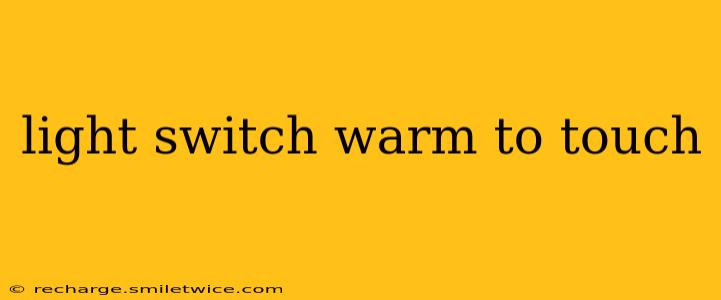Finding your light switch warm to the touch is unsettling. It's a sign that something might be amiss within your electrical system, and ignoring it could lead to more serious problems, including fire hazards. This article will explore the reasons why your light switch might be warm, helping you understand the potential risks and guiding you toward the appropriate course of action.
Why is My Light Switch Warm?
The most common reason a light switch feels warm is excessive current flow. This means more electricity than the switch is designed to handle is passing through it. This excess current generates heat, similar to how friction creates heat. Several factors can contribute to this:
-
Loose Connections: Loose wiring within the switch or at the connection points can create resistance, leading to increased heat generation. This is a significant safety concern, as loose connections can spark and potentially cause a fire.
-
Overloaded Circuit: If the circuit the light switch is on is overloaded (too many devices drawing power), it will force more current through the switch than it’s designed to handle. This often manifests as a warm or even hot switch.
-
Faulty Switch: The light switch itself could be failing. Internal components may be damaged or worn, causing increased resistance and heat buildup. This is especially likely if the switch is old or has been subjected to frequent on/off cycles.
-
Dimmers: Dimmer switches, while convenient, often generate more heat than standard switches. This is a normal phenomenon, but excessive heat beyond a gentle warmth warrants investigation.
-
High Wattage Bulbs: Using light bulbs that exceed the switch's rated wattage can also cause overheating. Always check the switch's rating and ensure your bulbs are compatible.
Is a Warm Light Switch Dangerous?
Yes, a consistently warm light switch is potentially dangerous. The excessive heat is a sign of a problem within the electrical system, and prolonged overheating can lead to:
-
Fire Hazard: Overheating can melt the wiring or the switch itself, potentially starting a fire. This is the most serious risk associated with a warm light switch.
-
Electrical Shock: Loose connections or faulty switches can expose live wires, increasing the risk of electrical shock.
-
Electrical Damage: The excessive current can damage other components in the electrical system, leading to further problems.
What Should I Do if My Light Switch is Warm?
Do not ignore a warm light switch. If you notice it's unusually warm to the touch, take the following steps:
-
Turn off the light switch and the circuit breaker. This is crucial to prevent further overheating and potential fire hazards.
-
Check for other signs of electrical problems. Look for flickering lights, burnt smells, or unusual noises coming from electrical outlets or appliances.
-
Contact a qualified electrician. A professional electrician can accurately diagnose the problem, identify the root cause, and perform the necessary repairs safely. This is essential to ensure the safety of your home and prevent further damage. Attempting repairs yourself can be dangerous if you're not properly trained.
How Can I Prevent a Warm Light Switch?
-
Avoid overloading circuits. Don't plug too many appliances into a single circuit.
-
Use appropriate wattage bulbs. Always check the wattage rating of your light switch and ensure your bulbs are compatible.
-
Regularly inspect your electrical system. Check for loose connections, frayed wires, and any other signs of damage.
-
Replace old or damaged switches. Replacing old switches with newer, higher-quality switches can reduce the risk of overheating.
-
Consider using LED bulbs: LED bulbs generate less heat compared to incandescent bulbs, which can help mitigate overheating.
What If My Dimmer Switch is Warm?
Dimmer switches inherently produce more heat than standard switches. However, excessive heat beyond a slight warmth is still a cause for concern. If your dimmer switch is excessively warm, it could indicate a problem with the dimmer itself or an overloaded circuit. Following the same steps as outlined above (turning off the switch and circuit breaker and contacting a qualified electrician) is crucial.
How Much Heat is Too Much?
There's no precise temperature threshold. If you feel significant heat—more than a slight warmth—when touching the light switch, it's a warning sign that requires attention. Trust your instincts; if it feels hotter than you'd expect, it's best to err on the side of caution and contact a professional.
Remember, addressing a warm light switch promptly is crucial for safety and preventing more extensive damage. Don't hesitate to call a qualified electrician to address the issue.
